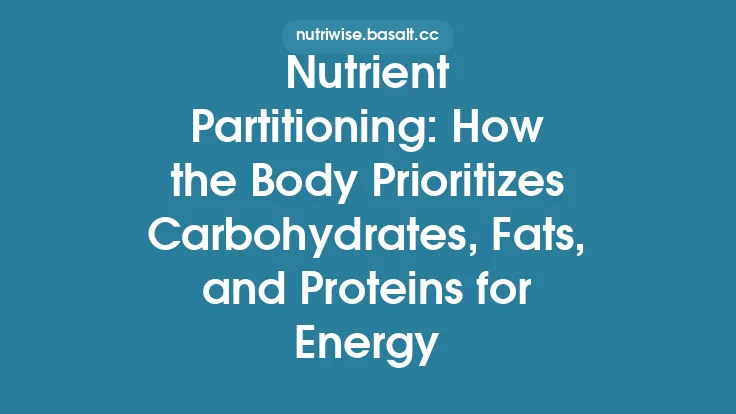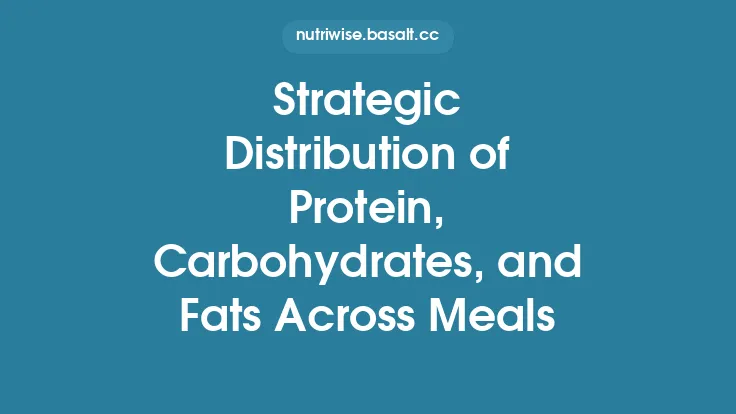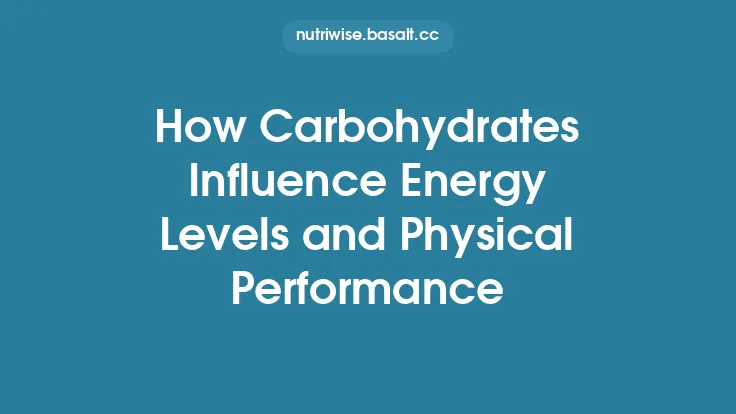Carbohydrates, fats, and proteins are the three macronutrients that supply the body with usable energy. While all three can ultimately be oxidized to carbon dioxide and water, the amount of chemical energy that each delivers per unit mass, the efficiency with which that energy is captured as ATP, and the metabolic “cost” of processing the nutrient differ markedly. Understanding these differences is essential for anyone who wants a clear picture of how the food we eat translates into the energy that powers every cellular function.
Caloric Density: The Most Immediate Comparison
| Macronutrient | Energy (kcal) per gram | Typical Water Content* | Energy (kJ) per gram |
|---|---|---|---|
| Carbohydrate | 4 | 10–20 % | 17 kJ |
| Protein | 4 | 15–25 % | 17 kJ |
| Fat | 9 | 0–5 % | 37 kJ |
*Water content varies with the specific food source (e.g., fresh fruit vs. dried grain).
The most obvious distinction is that fats contain more than twice the energy per gram of either carbohydrate or protein. This difference stems from the chemical structure: fats are long chains of carbon‑hydrogen bonds that are highly reduced, whereas carbohydrates and proteins contain more oxygen atoms, which already represent a partially oxidized state.
Oxidation Pathways and Net ATP Yield
Although the detailed enzymatic steps are beyond the scope of this article, the overall stoichiometry of complete oxidation can be expressed in terms of the number of high‑energy phosphate bonds (ATP equivalents) generated per molecule of substrate. The following values are widely accepted for the net ATP yield after accounting for the cost of transporting reducing equivalents into the mitochondria and for the synthesis of necessary by‑products (e.g., urea from protein nitrogen).
| Substrate (per molecule) | Carbon atoms | Net ATP produced* | ATP per gram |
|---|---|---|---|
| Glucose (C₆H₁₂O₆) | 6 | 30–32 | ~5.8 ATP g⁻¹ |
| Palmitic acid (C₁₆H₃₂O₂) | 16 | 106 | ~9.5 ATP g⁻¹ |
| Alanine (C₃H₇NO₂) | 3 | 12–13 (after deamination) | ~4.0 ATP g⁻¹ |
\*Values assume a P/O ratio of 2.5 for NADH and 1.5 for FADH₂, which reflects the current consensus for mitochondrial oxidative phosphorylation efficiency in mammals.
Key take‑aways
- Carbohydrates: One glucose molecule yields roughly 30–32 ATP. Because glucose is a six‑carbon molecule, the ATP yield per carbon atom is about 5.0 ATP/C.
- Fats: A typical long‑chain fatty acid such as palmitate yields over 100 ATP. The ATP per carbon is higher (~6.6 ATP/C) because fatty acids are more reduced and generate more FADH₂ during β‑oxidation, which feeds directly into the electron transport chain.
- Proteins: The net ATP from an amino acid depends on its carbon skeleton. After the amino group is removed (deamination), the remaining carbon skeleton enters the citric‑acid cycle at various points. On average, protein provides slightly less ATP per gram than carbohydrate because part of the substrate’s energy is expended in the urea cycle to safely excrete nitrogen.
Oxygen Utilization and Metabolic Efficiency
Energy yield can also be expressed as the amount of ATP generated per mole of O₂ consumed, a metric that reflects the efficiency of substrate oxidation in the respiratory chain.
| Substrate | Respiratory Quotient (RQ) | ATP per O₂ molecule |
|---|---|---|
| Carbohydrate (glucose) | 1.00 | ~5.0 |
| Fat (palmitate) | 0.70 | ~6.5 |
| Protein (mixed) | 0.80–0.85 | ~5.2 |
A lower RQ indicates that more oxygen is required to oxidize the substrate, but the higher ATP per O₂ for fats demonstrates that, per unit of oxygen, fats are the most efficient energy source. This property explains why, during prolonged low‑intensity exercise, the body increasingly relies on fat oxidation: the oxygen cost per ATP generated is minimized, preserving the limited oxygen supply.
Energy Yield After Accounting for Metabolic “Costs”
While the gross caloric values (4 kcal/g for carbs and protein, 9 kcal/g for fat) are useful for dietary planning, the net usable energy is slightly lower because the body must expend energy to:
- Deaminate amino acids – removing the nitrogen atom and converting the carbon skeleton into a usable form consumes ATP (approximately 1 ATP per amino acid deaminated).
- Synthesize urea – the urea cycle uses 2 ATP equivalents per molecule of urea formed, which corresponds to roughly 0.2 ATP per gram of protein.
- Transport fatty acids into mitochondria – the carnitine shuttle requires the hydrolysis of 1 ATP per fatty‑acid molecule (equivalent to ~0.02 ATP per gram of fat).
When these costs are subtracted, the effective energy yields become:
- Carbohydrate: ~3.8 kcal/g (≈ 16 kJ/g)
- Protein: ~3.5 kcal/g (≈ 15 kJ/g) – the reduction reflects the nitrogen‑handling expense.
- Fat: ~8.8 kcal/g (≈ 37 kJ/g) – the cost of mitochondrial import is minimal relative to the large energy pool.
These adjusted figures are still consistent with the widely quoted Atwater factors, confirming that the macronutrient energy values used in nutrition labeling are robust approximations of net usable energy.
Comparative Summary of Energy Yield
| Aspect | Carbohydrate | Fat | Protein |
|---|---|---|---|
| Caloric density | 4 kcal/g | 9 kcal/g | 4 kcal/g |
| Net ATP per gram | ~5.8 ATP/g | ~9.5 ATP/g | ~4.0 ATP/g |
| ATP per carbon atom | ~5.0 ATP/C | ~6.6 ATP/C | ~4.5 ATP/C (average) |
| ATP per O₂ | ~5.0 | ~6.5 | ~5.2 |
| Metabolic cost (nitrogen handling, transport) | Minimal | Small (carnitine shuttle) | Moderate (deamination + urea) |
| Effective usable energy | ~3.8 kcal/g | ~8.8 kcal/g | ~3.5 kcal/g |
Practical Implications of the Energy Yield Differences
- Energy density and storage – Because fat supplies the most ATP per gram and per unit of oxygen, the body stores excess energy primarily as triglycerides. This maximizes the amount of energy that can be retained in a relatively compact form.
- Rapid availability – Carbohydrates, despite a lower caloric density, can be mobilized quickly because glucose oxidation does not require the additional steps of fatty‑acid transport or amino‑acid deamination. This makes carbs the preferred fuel for high‑intensity, short‑duration activities.
- Protein as a secondary fuel – Protein’s primary role is structural and functional, not energetic. Its lower net ATP yield and the obligatory cost of nitrogen disposal mean that protein is only oxidized for energy when carbohydrate and fat supplies are insufficient.
Concluding Perspective
The three macronutrients differ fundamentally in how much chemical energy they contain, how efficiently that energy is captured as ATP, and how much ancillary metabolic work is required to make the energy available. Fats are the most energy‑dense and yield the greatest ATP per gram and per oxygen molecule, but they require transport into mitochondria. Carbohydrates provide a moderate amount of ATP with rapid accessibility and minimal processing overhead. Proteins deliver the least net ATP per gram, partly because part of their caloric value is diverted to safely eliminate nitrogen.
These intrinsic properties are immutable and form the basis for the body’s hierarchical use of fuels. By appreciating the quantitative differences in energy yield, readers can better understand why dietary recommendations, athletic nutrition strategies, and clinical nutrition plans often emphasize the balance of these macronutrients in relation to the body’s energy demands.





